Report: Strategic Change Management at Kiabi Malta - Analysis
VerifiedAdded on 2021/02/20
|16
|4984
|40
Report
AI Summary
This report provides an in-depth analysis of strategic change management within Kiabi Malta, a large French fashion retail brand. The report begins by discussing various models of strategic change, including Lewin's, ADKAR, and McKinsey's 7-S model, and evaluates their practical application within the economic context. It assesses the value of strategic intervention techniques, such as establishing a sense of urgency and communicating a change vision. The report then examines the needs and driving factors behind strategic change within the organization, including emerging technologies and customer demands. It also considers the implications of change on the organization. Furthermore, the report outlines systems for stakeholder involvement, change management strategies, and methods for managing resistance to change. Finally, it addresses the development of models for ongoing change and the process of implementing and monitoring change progress. The report highlights the importance of change for organizational development, growth, and competitive advantage.
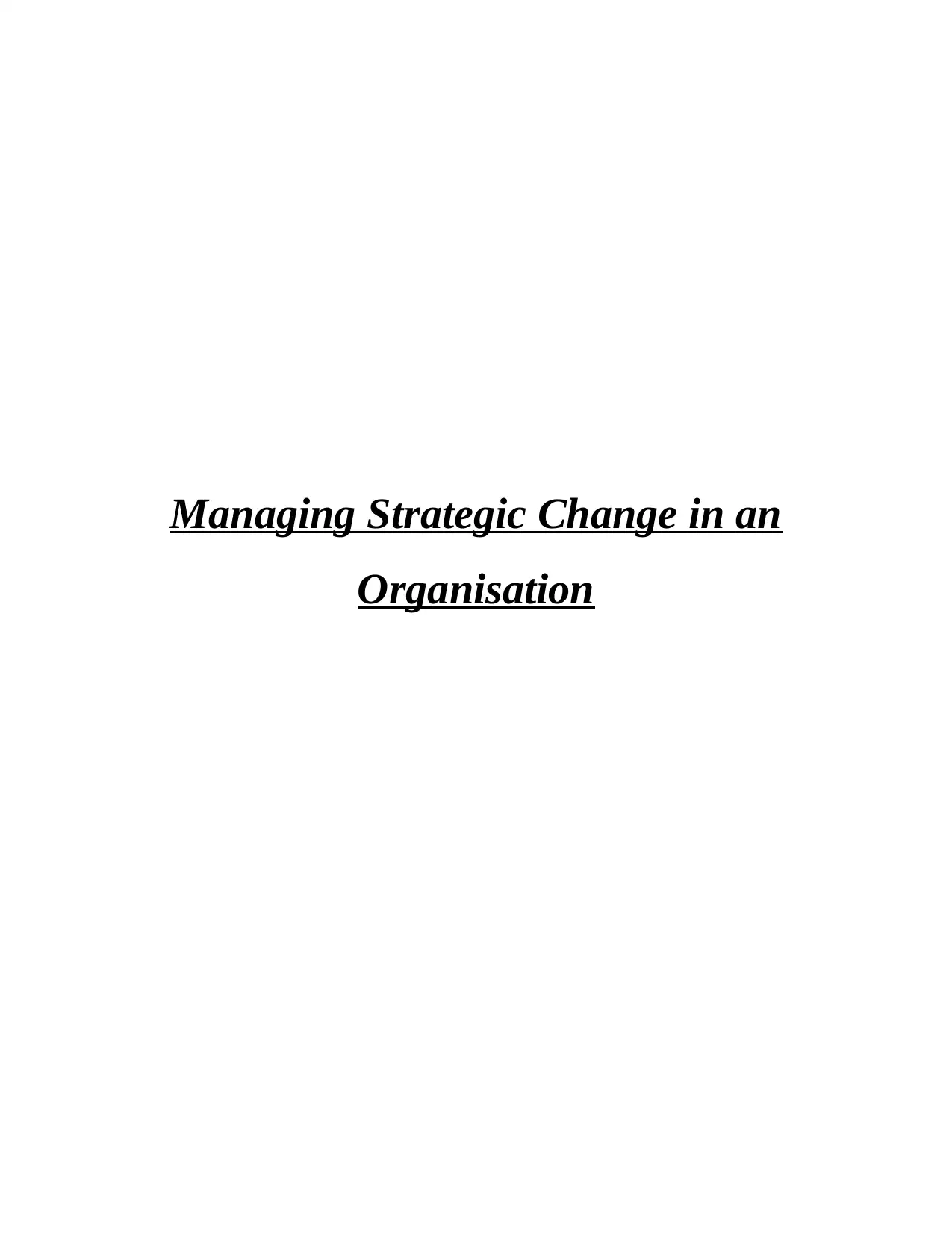
Managing Strategic Change in an
Organisation
Organisation
Paraphrase This Document
Need a fresh take? Get an instant paraphrase of this document with our AI Paraphraser
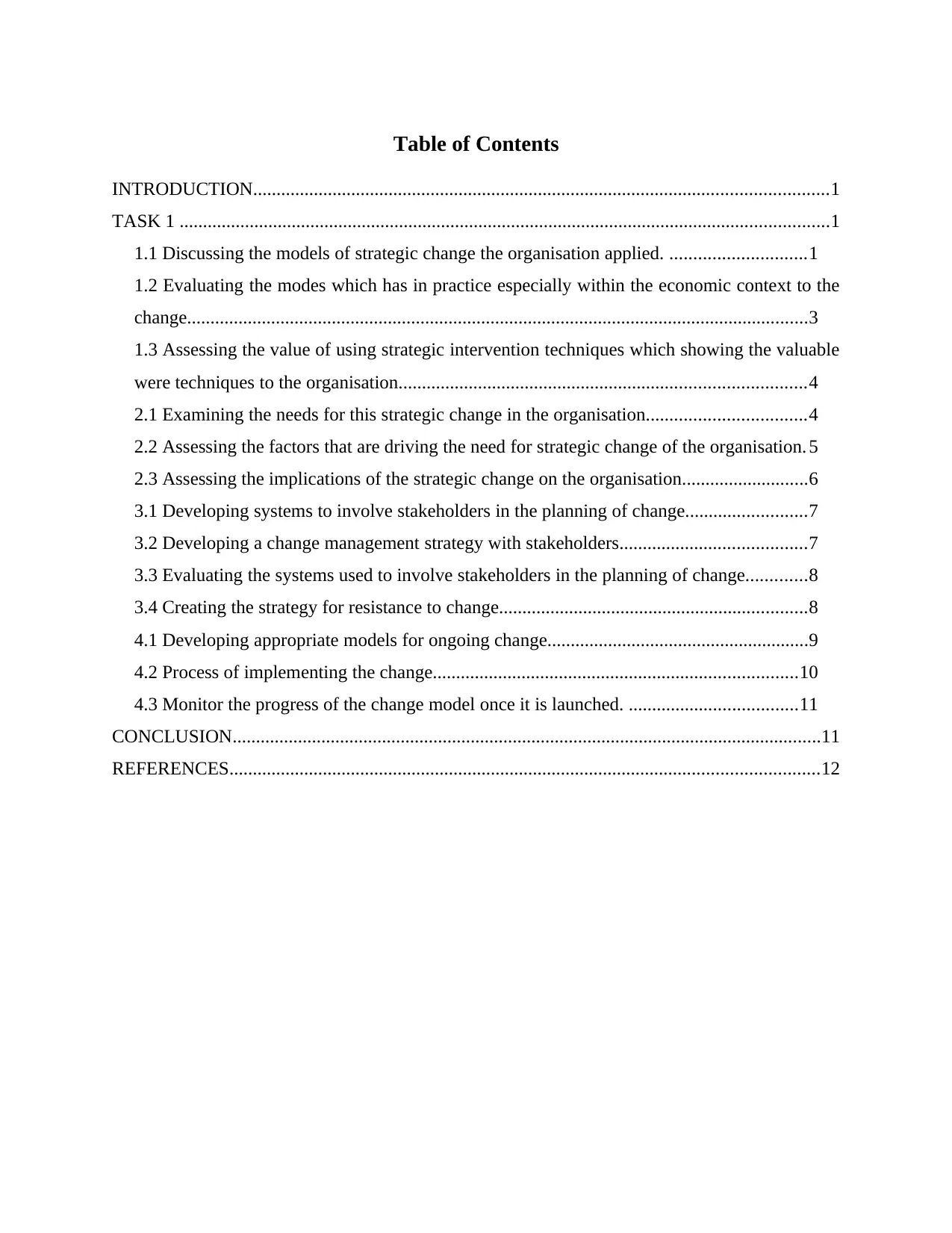
Table of Contents
INTRODUCTION...........................................................................................................................1
TASK 1 ...........................................................................................................................................1
1.1 Discussing the models of strategic change the organisation applied. .............................1
1.2 Evaluating the modes which has in practice especially within the economic context to the
change.....................................................................................................................................3
1.3 Assessing the value of using strategic intervention techniques which showing the valuable
were techniques to the organisation.......................................................................................4
2.1 Examining the needs for this strategic change in the organisation..................................4
2.2 Assessing the factors that are driving the need for strategic change of the organisation. 5
2.3 Assessing the implications of the strategic change on the organisation...........................6
3.1 Developing systems to involve stakeholders in the planning of change..........................7
3.2 Developing a change management strategy with stakeholders........................................7
3.3 Evaluating the systems used to involve stakeholders in the planning of change.............8
3.4 Creating the strategy for resistance to change..................................................................8
4.1 Developing appropriate models for ongoing change........................................................9
4.2 Process of implementing the change..............................................................................10
4.3 Monitor the progress of the change model once it is launched. ....................................11
CONCLUSION..............................................................................................................................11
REFERENCES..............................................................................................................................12
INTRODUCTION...........................................................................................................................1
TASK 1 ...........................................................................................................................................1
1.1 Discussing the models of strategic change the organisation applied. .............................1
1.2 Evaluating the modes which has in practice especially within the economic context to the
change.....................................................................................................................................3
1.3 Assessing the value of using strategic intervention techniques which showing the valuable
were techniques to the organisation.......................................................................................4
2.1 Examining the needs for this strategic change in the organisation..................................4
2.2 Assessing the factors that are driving the need for strategic change of the organisation. 5
2.3 Assessing the implications of the strategic change on the organisation...........................6
3.1 Developing systems to involve stakeholders in the planning of change..........................7
3.2 Developing a change management strategy with stakeholders........................................7
3.3 Evaluating the systems used to involve stakeholders in the planning of change.............8
3.4 Creating the strategy for resistance to change..................................................................8
4.1 Developing appropriate models for ongoing change........................................................9
4.2 Process of implementing the change..............................................................................10
4.3 Monitor the progress of the change model once it is launched. ....................................11
CONCLUSION..............................................................................................................................11
REFERENCES..............................................................................................................................12

⊘ This is a preview!⊘
Do you want full access?
Subscribe today to unlock all pages.

Trusted by 1+ million students worldwide
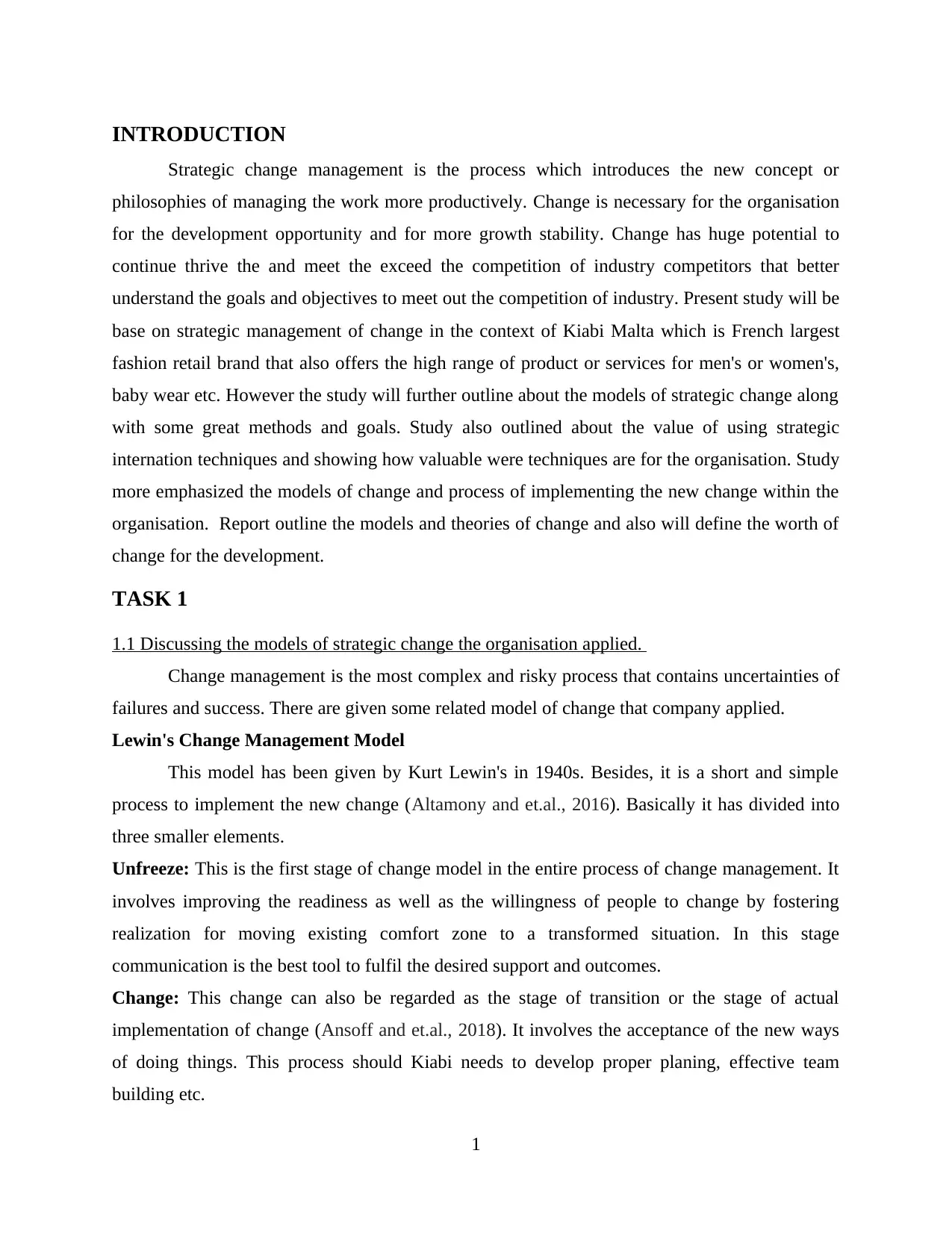
INTRODUCTION
Strategic change management is the process which introduces the new concept or
philosophies of managing the work more productively. Change is necessary for the organisation
for the development opportunity and for more growth stability. Change has huge potential to
continue thrive the and meet the exceed the competition of industry competitors that better
understand the goals and objectives to meet out the competition of industry. Present study will be
base on strategic management of change in the context of Kiabi Malta which is French largest
fashion retail brand that also offers the high range of product or services for men's or women's,
baby wear etc. However the study will further outline about the models of strategic change along
with some great methods and goals. Study also outlined about the value of using strategic
internation techniques and showing how valuable were techniques are for the organisation. Study
more emphasized the models of change and process of implementing the new change within the
organisation. Report outline the models and theories of change and also will define the worth of
change for the development.
TASK 1
1.1 Discussing the models of strategic change the organisation applied.
Change management is the most complex and risky process that contains uncertainties of
failures and success. There are given some related model of change that company applied.
Lewin's Change Management Model
This model has been given by Kurt Lewin's in 1940s. Besides, it is a short and simple
process to implement the new change (Altamony and et.al., 2016). Basically it has divided into
three smaller elements.
Unfreeze: This is the first stage of change model in the entire process of change management. It
involves improving the readiness as well as the willingness of people to change by fostering
realization for moving existing comfort zone to a transformed situation. In this stage
communication is the best tool to fulfil the desired support and outcomes.
Change: This change can also be regarded as the stage of transition or the stage of actual
implementation of change (Ansoff and et.al., 2018). It involves the acceptance of the new ways
of doing things. This process should Kiabi needs to develop proper planing, effective team
building etc.
1
Strategic change management is the process which introduces the new concept or
philosophies of managing the work more productively. Change is necessary for the organisation
for the development opportunity and for more growth stability. Change has huge potential to
continue thrive the and meet the exceed the competition of industry competitors that better
understand the goals and objectives to meet out the competition of industry. Present study will be
base on strategic management of change in the context of Kiabi Malta which is French largest
fashion retail brand that also offers the high range of product or services for men's or women's,
baby wear etc. However the study will further outline about the models of strategic change along
with some great methods and goals. Study also outlined about the value of using strategic
internation techniques and showing how valuable were techniques are for the organisation. Study
more emphasized the models of change and process of implementing the new change within the
organisation. Report outline the models and theories of change and also will define the worth of
change for the development.
TASK 1
1.1 Discussing the models of strategic change the organisation applied.
Change management is the most complex and risky process that contains uncertainties of
failures and success. There are given some related model of change that company applied.
Lewin's Change Management Model
This model has been given by Kurt Lewin's in 1940s. Besides, it is a short and simple
process to implement the new change (Altamony and et.al., 2016). Basically it has divided into
three smaller elements.
Unfreeze: This is the first stage of change model in the entire process of change management. It
involves improving the readiness as well as the willingness of people to change by fostering
realization for moving existing comfort zone to a transformed situation. In this stage
communication is the best tool to fulfil the desired support and outcomes.
Change: This change can also be regarded as the stage of transition or the stage of actual
implementation of change (Ansoff and et.al., 2018). It involves the acceptance of the new ways
of doing things. This process should Kiabi needs to develop proper planing, effective team
building etc.
1
Paraphrase This Document
Need a fresh take? Get an instant paraphrase of this document with our AI Paraphraser
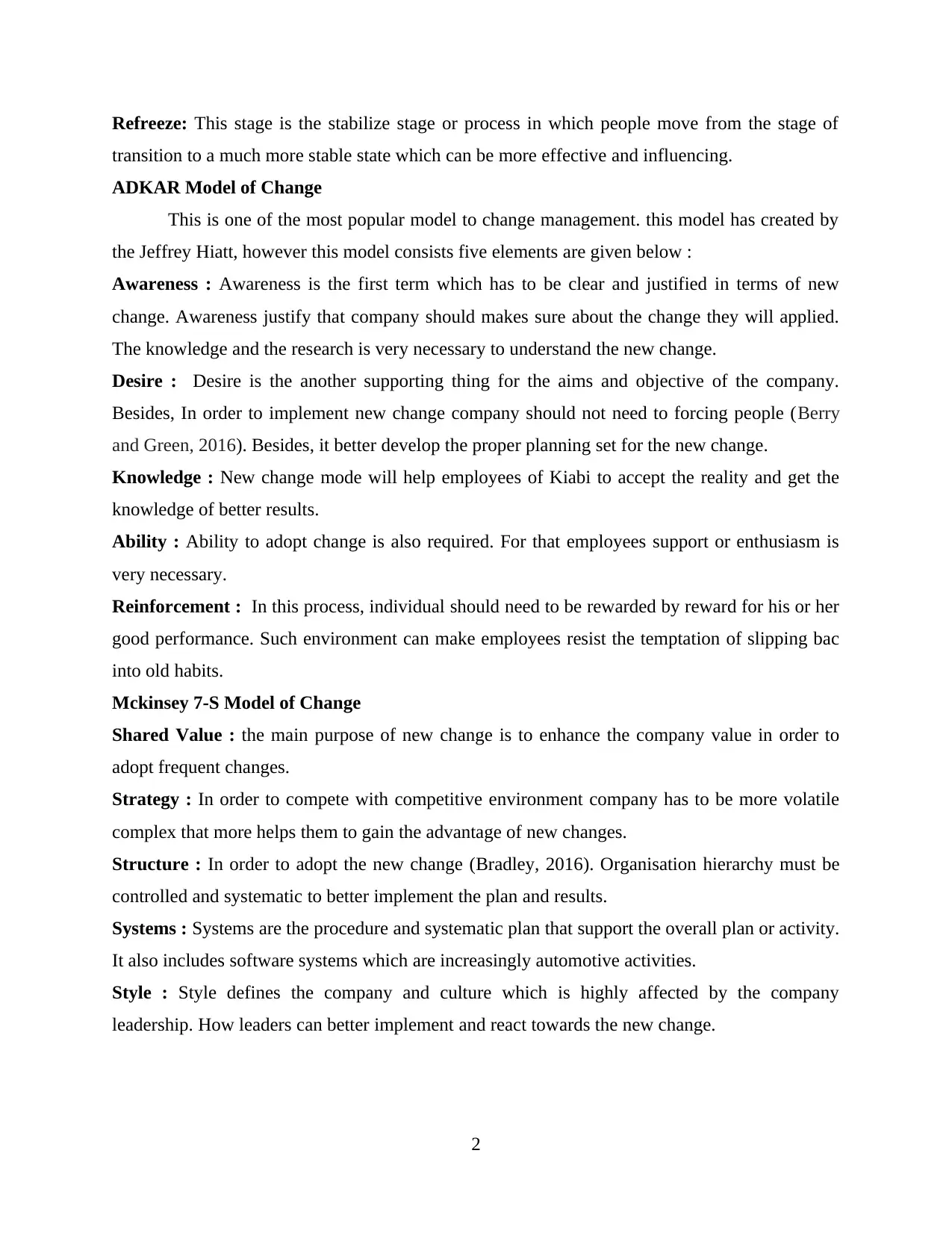
Refreeze: This stage is the stabilize stage or process in which people move from the stage of
transition to a much more stable state which can be more effective and influencing.
ADKAR Model of Change
This is one of the most popular model to change management. this model has created by
the Jeffrey Hiatt, however this model consists five elements are given below :
Awareness : Awareness is the first term which has to be clear and justified in terms of new
change. Awareness justify that company should makes sure about the change they will applied.
The knowledge and the research is very necessary to understand the new change.
Desire : Desire is the another supporting thing for the aims and objective of the company.
Besides, In order to implement new change company should not need to forcing people (Berry
and Green, 2016). Besides, it better develop the proper planning set for the new change.
Knowledge : New change mode will help employees of Kiabi to accept the reality and get the
knowledge of better results.
Ability : Ability to adopt change is also required. For that employees support or enthusiasm is
very necessary.
Reinforcement : In this process, individual should need to be rewarded by reward for his or her
good performance. Such environment can make employees resist the temptation of slipping bac
into old habits.
Mckinsey 7-S Model of Change
Shared Value : the main purpose of new change is to enhance the company value in order to
adopt frequent changes.
Strategy : In order to compete with competitive environment company has to be more volatile
complex that more helps them to gain the advantage of new changes.
Structure : In order to adopt the new change (Bradley, 2016). Organisation hierarchy must be
controlled and systematic to better implement the plan and results.
Systems : Systems are the procedure and systematic plan that support the overall plan or activity.
It also includes software systems which are increasingly automotive activities.
Style : Style defines the company and culture which is highly affected by the company
leadership. How leaders can better implement and react towards the new change.
2
transition to a much more stable state which can be more effective and influencing.
ADKAR Model of Change
This is one of the most popular model to change management. this model has created by
the Jeffrey Hiatt, however this model consists five elements are given below :
Awareness : Awareness is the first term which has to be clear and justified in terms of new
change. Awareness justify that company should makes sure about the change they will applied.
The knowledge and the research is very necessary to understand the new change.
Desire : Desire is the another supporting thing for the aims and objective of the company.
Besides, In order to implement new change company should not need to forcing people (Berry
and Green, 2016). Besides, it better develop the proper planning set for the new change.
Knowledge : New change mode will help employees of Kiabi to accept the reality and get the
knowledge of better results.
Ability : Ability to adopt change is also required. For that employees support or enthusiasm is
very necessary.
Reinforcement : In this process, individual should need to be rewarded by reward for his or her
good performance. Such environment can make employees resist the temptation of slipping bac
into old habits.
Mckinsey 7-S Model of Change
Shared Value : the main purpose of new change is to enhance the company value in order to
adopt frequent changes.
Strategy : In order to compete with competitive environment company has to be more volatile
complex that more helps them to gain the advantage of new changes.
Structure : In order to adopt the new change (Bradley, 2016). Organisation hierarchy must be
controlled and systematic to better implement the plan and results.
Systems : Systems are the procedure and systematic plan that support the overall plan or activity.
It also includes software systems which are increasingly automotive activities.
Style : Style defines the company and culture which is highly affected by the company
leadership. How leaders can better implement and react towards the new change.
2
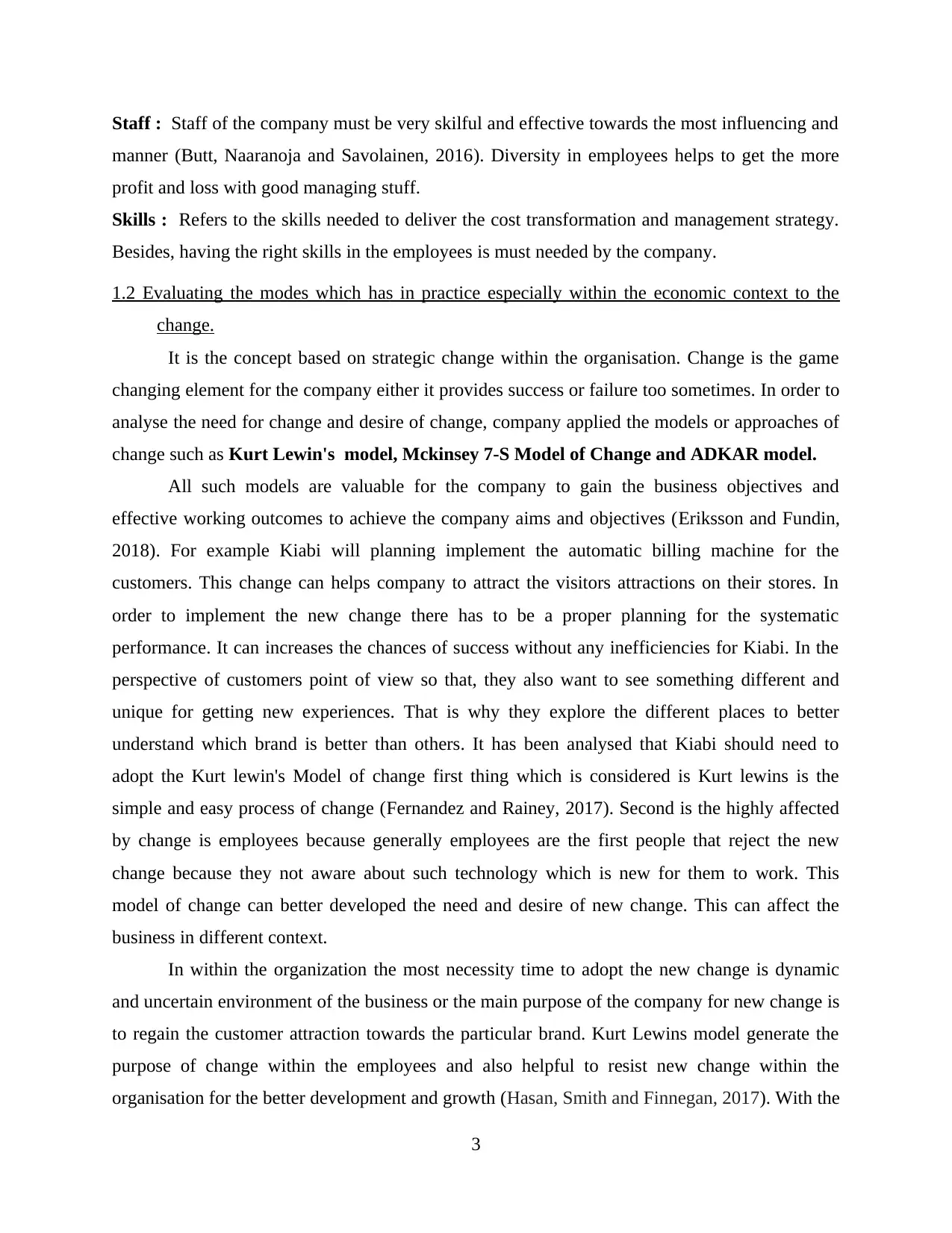
Staff : Staff of the company must be very skilful and effective towards the most influencing and
manner (Butt, Naaranoja and Savolainen, 2016). Diversity in employees helps to get the more
profit and loss with good managing stuff.
Skills : Refers to the skills needed to deliver the cost transformation and management strategy.
Besides, having the right skills in the employees is must needed by the company.
1.2 Evaluating the modes which has in practice especially within the economic context to the
change.
It is the concept based on strategic change within the organisation. Change is the game
changing element for the company either it provides success or failure too sometimes. In order to
analyse the need for change and desire of change, company applied the models or approaches of
change such as Kurt Lewin's model, Mckinsey 7-S Model of Change and ADKAR model.
All such models are valuable for the company to gain the business objectives and
effective working outcomes to achieve the company aims and objectives (Eriksson and Fundin,
2018). For example Kiabi will planning implement the automatic billing machine for the
customers. This change can helps company to attract the visitors attractions on their stores. In
order to implement the new change there has to be a proper planning for the systematic
performance. It can increases the chances of success without any inefficiencies for Kiabi. In the
perspective of customers point of view so that, they also want to see something different and
unique for getting new experiences. That is why they explore the different places to better
understand which brand is better than others. It has been analysed that Kiabi should need to
adopt the Kurt lewin's Model of change first thing which is considered is Kurt lewins is the
simple and easy process of change (Fernandez and Rainey, 2017). Second is the highly affected
by change is employees because generally employees are the first people that reject the new
change because they not aware about such technology which is new for them to work. This
model of change can better developed the need and desire of new change. This can affect the
business in different context.
In within the organization the most necessity time to adopt the new change is dynamic
and uncertain environment of the business or the main purpose of the company for new change is
to regain the customer attraction towards the particular brand. Kurt Lewins model generate the
purpose of change within the employees and also helpful to resist new change within the
organisation for the better development and growth (Hasan, Smith and Finnegan, 2017). With the
3
manner (Butt, Naaranoja and Savolainen, 2016). Diversity in employees helps to get the more
profit and loss with good managing stuff.
Skills : Refers to the skills needed to deliver the cost transformation and management strategy.
Besides, having the right skills in the employees is must needed by the company.
1.2 Evaluating the modes which has in practice especially within the economic context to the
change.
It is the concept based on strategic change within the organisation. Change is the game
changing element for the company either it provides success or failure too sometimes. In order to
analyse the need for change and desire of change, company applied the models or approaches of
change such as Kurt Lewin's model, Mckinsey 7-S Model of Change and ADKAR model.
All such models are valuable for the company to gain the business objectives and
effective working outcomes to achieve the company aims and objectives (Eriksson and Fundin,
2018). For example Kiabi will planning implement the automatic billing machine for the
customers. This change can helps company to attract the visitors attractions on their stores. In
order to implement the new change there has to be a proper planning for the systematic
performance. It can increases the chances of success without any inefficiencies for Kiabi. In the
perspective of customers point of view so that, they also want to see something different and
unique for getting new experiences. That is why they explore the different places to better
understand which brand is better than others. It has been analysed that Kiabi should need to
adopt the Kurt lewin's Model of change first thing which is considered is Kurt lewins is the
simple and easy process of change (Fernandez and Rainey, 2017). Second is the highly affected
by change is employees because generally employees are the first people that reject the new
change because they not aware about such technology which is new for them to work. This
model of change can better developed the need and desire of new change. This can affect the
business in different context.
In within the organization the most necessity time to adopt the new change is dynamic
and uncertain environment of the business or the main purpose of the company for new change is
to regain the customer attraction towards the particular brand. Kurt Lewins model generate the
purpose of change within the employees and also helpful to resist new change within the
organisation for the better development and growth (Hasan, Smith and Finnegan, 2017). With the
3
⊘ This is a preview!⊘
Do you want full access?
Subscribe today to unlock all pages.

Trusted by 1+ million students worldwide
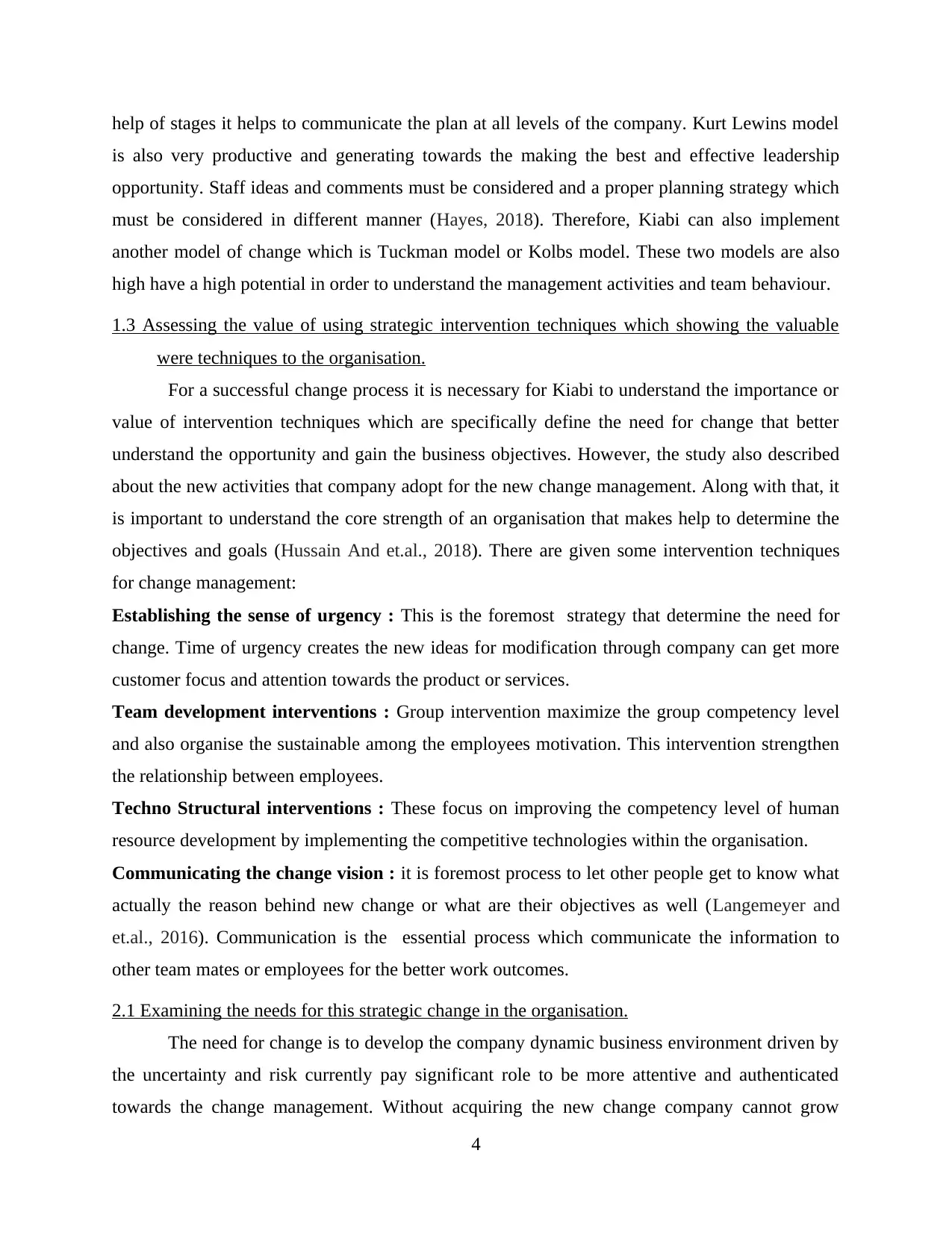
help of stages it helps to communicate the plan at all levels of the company. Kurt Lewins model
is also very productive and generating towards the making the best and effective leadership
opportunity. Staff ideas and comments must be considered and a proper planning strategy which
must be considered in different manner (Hayes, 2018). Therefore, Kiabi can also implement
another model of change which is Tuckman model or Kolbs model. These two models are also
high have a high potential in order to understand the management activities and team behaviour.
1.3 Assessing the value of using strategic intervention techniques which showing the valuable
were techniques to the organisation.
For a successful change process it is necessary for Kiabi to understand the importance or
value of intervention techniques which are specifically define the need for change that better
understand the opportunity and gain the business objectives. However, the study also described
about the new activities that company adopt for the new change management. Along with that, it
is important to understand the core strength of an organisation that makes help to determine the
objectives and goals (Hussain And et.al., 2018). There are given some intervention techniques
for change management:
Establishing the sense of urgency : This is the foremost strategy that determine the need for
change. Time of urgency creates the new ideas for modification through company can get more
customer focus and attention towards the product or services.
Team development interventions : Group intervention maximize the group competency level
and also organise the sustainable among the employees motivation. This intervention strengthen
the relationship between employees.
Techno Structural interventions : These focus on improving the competency level of human
resource development by implementing the competitive technologies within the organisation.
Communicating the change vision : it is foremost process to let other people get to know what
actually the reason behind new change or what are their objectives as well (Langemeyer and
et.al., 2016). Communication is the essential process which communicate the information to
other team mates or employees for the better work outcomes.
2.1 Examining the needs for this strategic change in the organisation.
The need for change is to develop the company dynamic business environment driven by
the uncertainty and risk currently pay significant role to be more attentive and authenticated
towards the change management. Without acquiring the new change company cannot grow
4
is also very productive and generating towards the making the best and effective leadership
opportunity. Staff ideas and comments must be considered and a proper planning strategy which
must be considered in different manner (Hayes, 2018). Therefore, Kiabi can also implement
another model of change which is Tuckman model or Kolbs model. These two models are also
high have a high potential in order to understand the management activities and team behaviour.
1.3 Assessing the value of using strategic intervention techniques which showing the valuable
were techniques to the organisation.
For a successful change process it is necessary for Kiabi to understand the importance or
value of intervention techniques which are specifically define the need for change that better
understand the opportunity and gain the business objectives. However, the study also described
about the new activities that company adopt for the new change management. Along with that, it
is important to understand the core strength of an organisation that makes help to determine the
objectives and goals (Hussain And et.al., 2018). There are given some intervention techniques
for change management:
Establishing the sense of urgency : This is the foremost strategy that determine the need for
change. Time of urgency creates the new ideas for modification through company can get more
customer focus and attention towards the product or services.
Team development interventions : Group intervention maximize the group competency level
and also organise the sustainable among the employees motivation. This intervention strengthen
the relationship between employees.
Techno Structural interventions : These focus on improving the competency level of human
resource development by implementing the competitive technologies within the organisation.
Communicating the change vision : it is foremost process to let other people get to know what
actually the reason behind new change or what are their objectives as well (Langemeyer and
et.al., 2016). Communication is the essential process which communicate the information to
other team mates or employees for the better work outcomes.
2.1 Examining the needs for this strategic change in the organisation.
The need for change is to develop the company dynamic business environment driven by
the uncertainty and risk currently pay significant role to be more attentive and authenticated
towards the change management. Without acquiring the new change company cannot grow
4
Paraphrase This Document
Need a fresh take? Get an instant paraphrase of this document with our AI Paraphraser
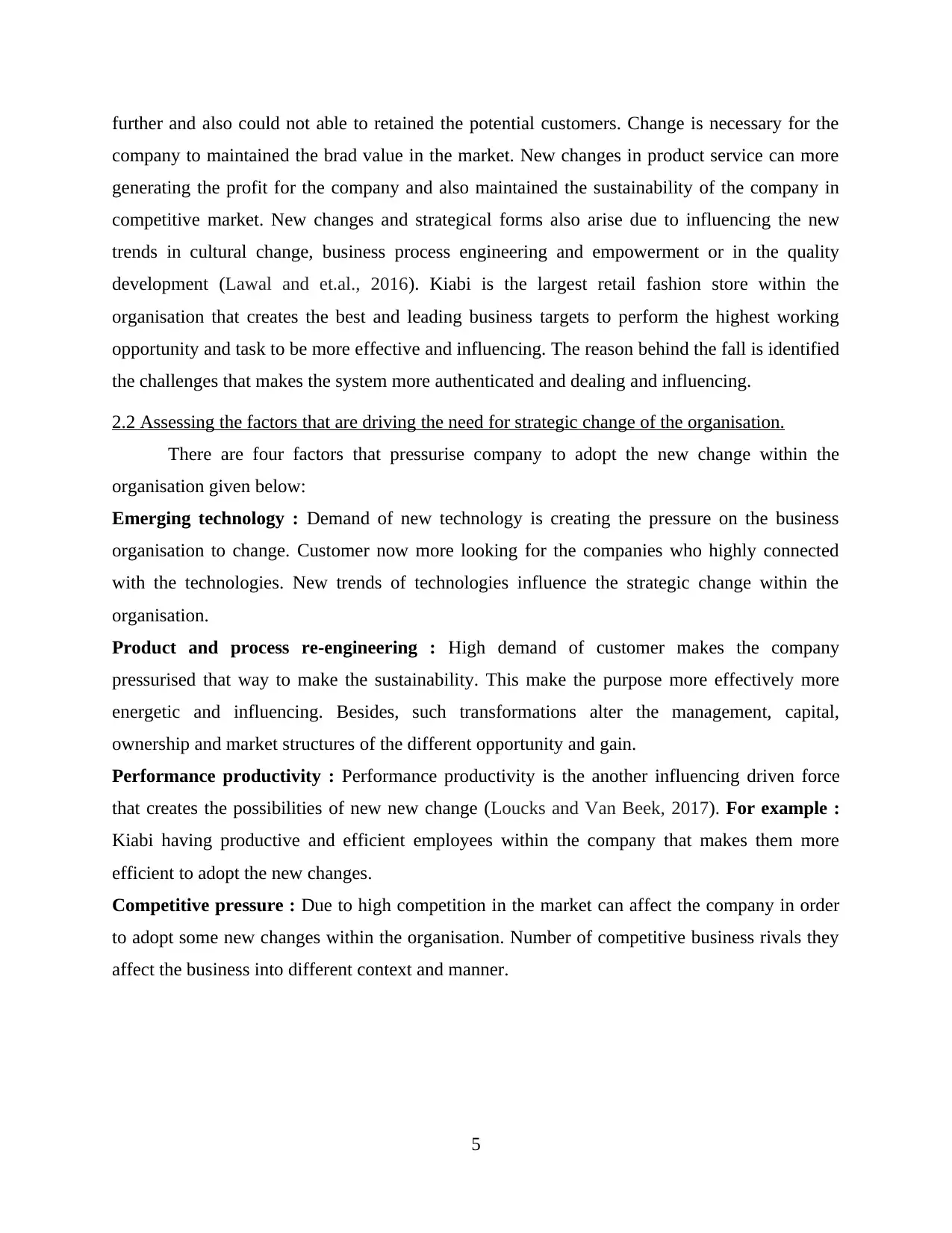
further and also could not able to retained the potential customers. Change is necessary for the
company to maintained the brad value in the market. New changes in product service can more
generating the profit for the company and also maintained the sustainability of the company in
competitive market. New changes and strategical forms also arise due to influencing the new
trends in cultural change, business process engineering and empowerment or in the quality
development (Lawal and et.al., 2016). Kiabi is the largest retail fashion store within the
organisation that creates the best and leading business targets to perform the highest working
opportunity and task to be more effective and influencing. The reason behind the fall is identified
the challenges that makes the system more authenticated and dealing and influencing.
2.2 Assessing the factors that are driving the need for strategic change of the organisation.
There are four factors that pressurise company to adopt the new change within the
organisation given below:
Emerging technology : Demand of new technology is creating the pressure on the business
organisation to change. Customer now more looking for the companies who highly connected
with the technologies. New trends of technologies influence the strategic change within the
organisation.
Product and process re-engineering : High demand of customer makes the company
pressurised that way to make the sustainability. This make the purpose more effectively more
energetic and influencing. Besides, such transformations alter the management, capital,
ownership and market structures of the different opportunity and gain.
Performance productivity : Performance productivity is the another influencing driven force
that creates the possibilities of new new change (Loucks and Van Beek, 2017). For example :
Kiabi having productive and efficient employees within the company that makes them more
efficient to adopt the new changes.
Competitive pressure : Due to high competition in the market can affect the company in order
to adopt some new changes within the organisation. Number of competitive business rivals they
affect the business into different context and manner.
5
company to maintained the brad value in the market. New changes in product service can more
generating the profit for the company and also maintained the sustainability of the company in
competitive market. New changes and strategical forms also arise due to influencing the new
trends in cultural change, business process engineering and empowerment or in the quality
development (Lawal and et.al., 2016). Kiabi is the largest retail fashion store within the
organisation that creates the best and leading business targets to perform the highest working
opportunity and task to be more effective and influencing. The reason behind the fall is identified
the challenges that makes the system more authenticated and dealing and influencing.
2.2 Assessing the factors that are driving the need for strategic change of the organisation.
There are four factors that pressurise company to adopt the new change within the
organisation given below:
Emerging technology : Demand of new technology is creating the pressure on the business
organisation to change. Customer now more looking for the companies who highly connected
with the technologies. New trends of technologies influence the strategic change within the
organisation.
Product and process re-engineering : High demand of customer makes the company
pressurised that way to make the sustainability. This make the purpose more effectively more
energetic and influencing. Besides, such transformations alter the management, capital,
ownership and market structures of the different opportunity and gain.
Performance productivity : Performance productivity is the another influencing driven force
that creates the possibilities of new new change (Loucks and Van Beek, 2017). For example :
Kiabi having productive and efficient employees within the company that makes them more
efficient to adopt the new changes.
Competitive pressure : Due to high competition in the market can affect the company in order
to adopt some new changes within the organisation. Number of competitive business rivals they
affect the business into different context and manner.
5
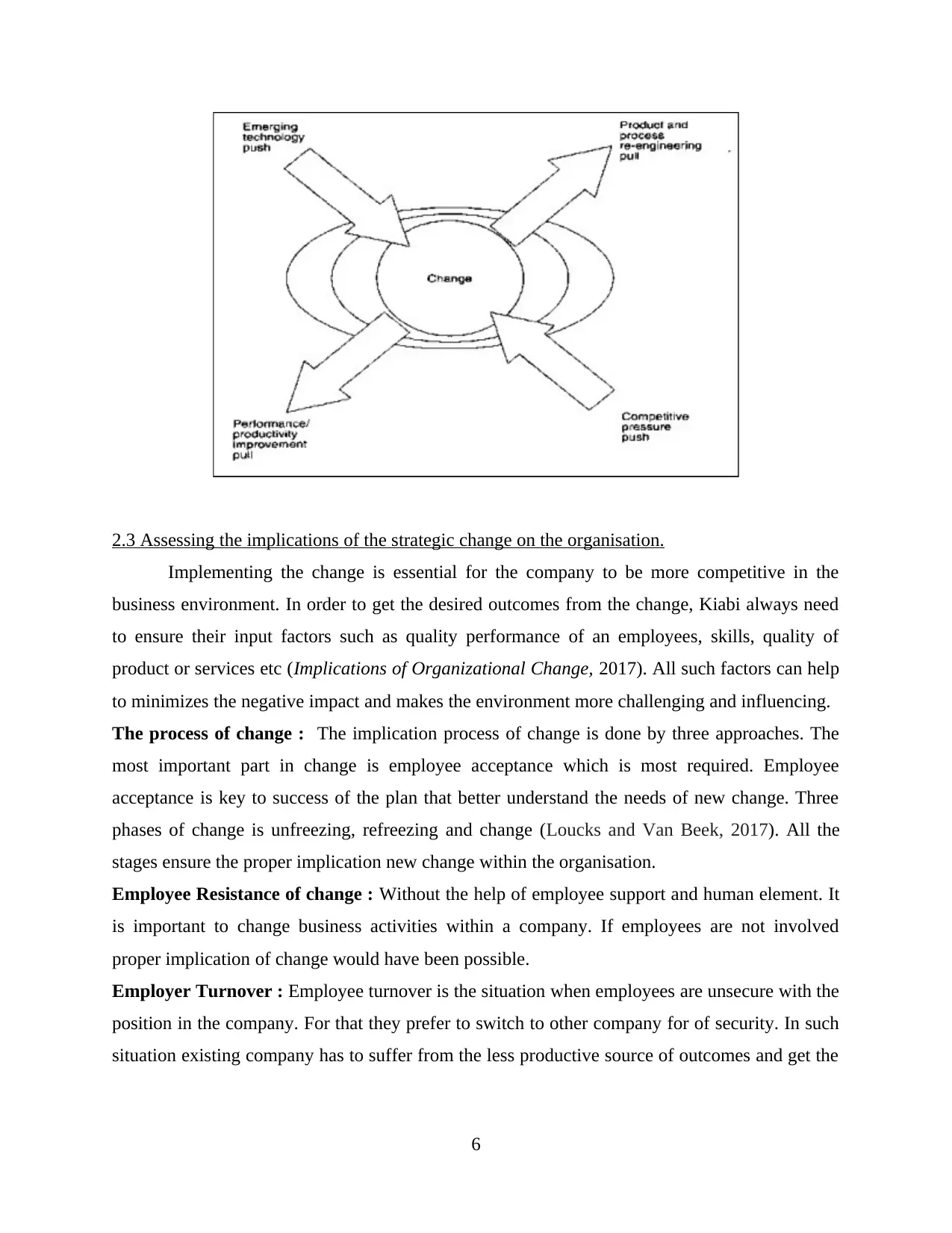
2.3 Assessing the implications of the strategic change on the organisation.
Implementing the change is essential for the company to be more competitive in the
business environment. In order to get the desired outcomes from the change, Kiabi always need
to ensure their input factors such as quality performance of an employees, skills, quality of
product or services etc (Implications of Organizational Change, 2017). All such factors can help
to minimizes the negative impact and makes the environment more challenging and influencing.
The process of change : The implication process of change is done by three approaches. The
most important part in change is employee acceptance which is most required. Employee
acceptance is key to success of the plan that better understand the needs of new change. Three
phases of change is unfreezing, refreezing and change (Loucks and Van Beek, 2017). All the
stages ensure the proper implication new change within the organisation.
Employee Resistance of change : Without the help of employee support and human element. It
is important to change business activities within a company. If employees are not involved
proper implication of change would have been possible.
Employer Turnover : Employee turnover is the situation when employees are unsecure with the
position in the company. For that they prefer to switch to other company for of security. In such
situation existing company has to suffer from the less productive source of outcomes and get the
6
Implementing the change is essential for the company to be more competitive in the
business environment. In order to get the desired outcomes from the change, Kiabi always need
to ensure their input factors such as quality performance of an employees, skills, quality of
product or services etc (Implications of Organizational Change, 2017). All such factors can help
to minimizes the negative impact and makes the environment more challenging and influencing.
The process of change : The implication process of change is done by three approaches. The
most important part in change is employee acceptance which is most required. Employee
acceptance is key to success of the plan that better understand the needs of new change. Three
phases of change is unfreezing, refreezing and change (Loucks and Van Beek, 2017). All the
stages ensure the proper implication new change within the organisation.
Employee Resistance of change : Without the help of employee support and human element. It
is important to change business activities within a company. If employees are not involved
proper implication of change would have been possible.
Employer Turnover : Employee turnover is the situation when employees are unsecure with the
position in the company. For that they prefer to switch to other company for of security. In such
situation existing company has to suffer from the less productive source of outcomes and get the
6
⊘ This is a preview!⊘
Do you want full access?
Subscribe today to unlock all pages.

Trusted by 1+ million students worldwide
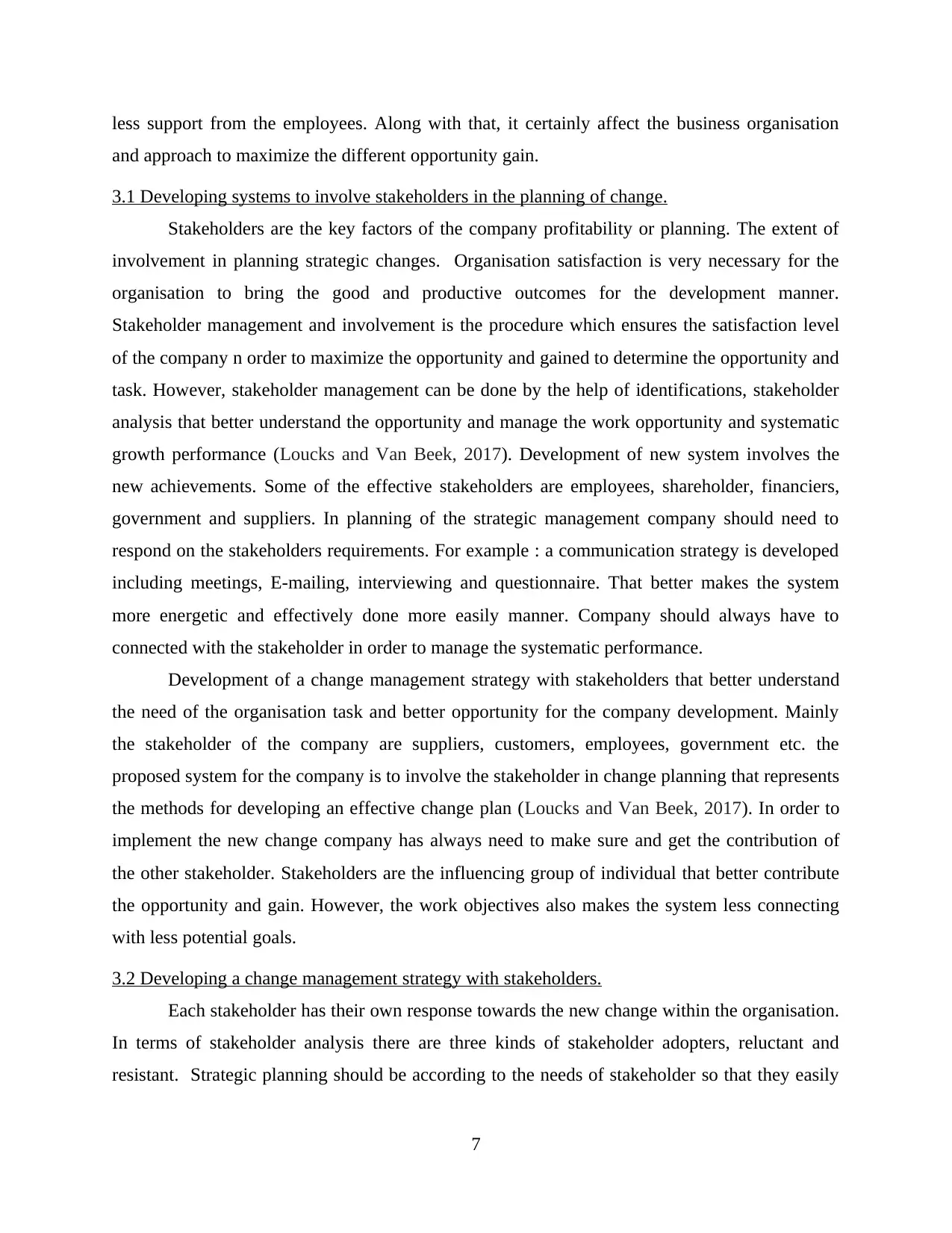
less support from the employees. Along with that, it certainly affect the business organisation
and approach to maximize the different opportunity gain.
3.1 Developing systems to involve stakeholders in the planning of change.
Stakeholders are the key factors of the company profitability or planning. The extent of
involvement in planning strategic changes. Organisation satisfaction is very necessary for the
organisation to bring the good and productive outcomes for the development manner.
Stakeholder management and involvement is the procedure which ensures the satisfaction level
of the company n order to maximize the opportunity and gained to determine the opportunity and
task. However, stakeholder management can be done by the help of identifications, stakeholder
analysis that better understand the opportunity and manage the work opportunity and systematic
growth performance (Loucks and Van Beek, 2017). Development of new system involves the
new achievements. Some of the effective stakeholders are employees, shareholder, financiers,
government and suppliers. In planning of the strategic management company should need to
respond on the stakeholders requirements. For example : a communication strategy is developed
including meetings, E-mailing, interviewing and questionnaire. That better makes the system
more energetic and effectively done more easily manner. Company should always have to
connected with the stakeholder in order to manage the systematic performance.
Development of a change management strategy with stakeholders that better understand
the need of the organisation task and better opportunity for the company development. Mainly
the stakeholder of the company are suppliers, customers, employees, government etc. the
proposed system for the company is to involve the stakeholder in change planning that represents
the methods for developing an effective change plan (Loucks and Van Beek, 2017). In order to
implement the new change company has always need to make sure and get the contribution of
the other stakeholder. Stakeholders are the influencing group of individual that better contribute
the opportunity and gain. However, the work objectives also makes the system less connecting
with less potential goals.
3.2 Developing a change management strategy with stakeholders.
Each stakeholder has their own response towards the new change within the organisation.
In terms of stakeholder analysis there are three kinds of stakeholder adopters, reluctant and
resistant. Strategic planning should be according to the needs of stakeholder so that they easily
7
and approach to maximize the different opportunity gain.
3.1 Developing systems to involve stakeholders in the planning of change.
Stakeholders are the key factors of the company profitability or planning. The extent of
involvement in planning strategic changes. Organisation satisfaction is very necessary for the
organisation to bring the good and productive outcomes for the development manner.
Stakeholder management and involvement is the procedure which ensures the satisfaction level
of the company n order to maximize the opportunity and gained to determine the opportunity and
task. However, stakeholder management can be done by the help of identifications, stakeholder
analysis that better understand the opportunity and manage the work opportunity and systematic
growth performance (Loucks and Van Beek, 2017). Development of new system involves the
new achievements. Some of the effective stakeholders are employees, shareholder, financiers,
government and suppliers. In planning of the strategic management company should need to
respond on the stakeholders requirements. For example : a communication strategy is developed
including meetings, E-mailing, interviewing and questionnaire. That better makes the system
more energetic and effectively done more easily manner. Company should always have to
connected with the stakeholder in order to manage the systematic performance.
Development of a change management strategy with stakeholders that better understand
the need of the organisation task and better opportunity for the company development. Mainly
the stakeholder of the company are suppliers, customers, employees, government etc. the
proposed system for the company is to involve the stakeholder in change planning that represents
the methods for developing an effective change plan (Loucks and Van Beek, 2017). In order to
implement the new change company has always need to make sure and get the contribution of
the other stakeholder. Stakeholders are the influencing group of individual that better contribute
the opportunity and gain. However, the work objectives also makes the system less connecting
with less potential goals.
3.2 Developing a change management strategy with stakeholders.
Each stakeholder has their own response towards the new change within the organisation.
In terms of stakeholder analysis there are three kinds of stakeholder adopters, reluctant and
resistant. Strategic planning should be according to the needs of stakeholder so that they easily
7
Paraphrase This Document
Need a fresh take? Get an instant paraphrase of this document with our AI Paraphraser
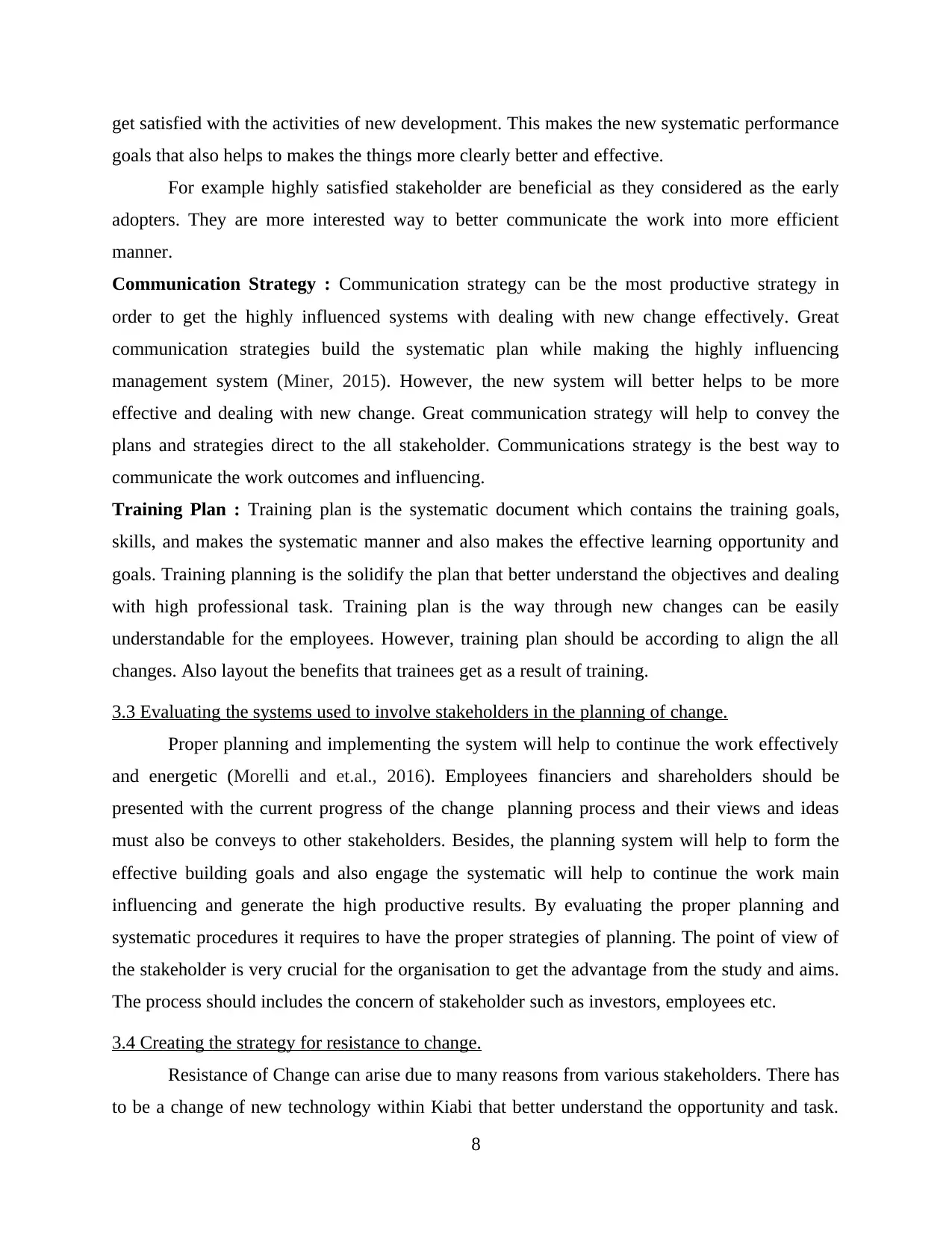
get satisfied with the activities of new development. This makes the new systematic performance
goals that also helps to makes the things more clearly better and effective.
For example highly satisfied stakeholder are beneficial as they considered as the early
adopters. They are more interested way to better communicate the work into more efficient
manner.
Communication Strategy : Communication strategy can be the most productive strategy in
order to get the highly influenced systems with dealing with new change effectively. Great
communication strategies build the systematic plan while making the highly influencing
management system (Miner, 2015). However, the new system will better helps to be more
effective and dealing with new change. Great communication strategy will help to convey the
plans and strategies direct to the all stakeholder. Communications strategy is the best way to
communicate the work outcomes and influencing.
Training Plan : Training plan is the systematic document which contains the training goals,
skills, and makes the systematic manner and also makes the effective learning opportunity and
goals. Training planning is the solidify the plan that better understand the objectives and dealing
with high professional task. Training plan is the way through new changes can be easily
understandable for the employees. However, training plan should be according to align the all
changes. Also layout the benefits that trainees get as a result of training.
3.3 Evaluating the systems used to involve stakeholders in the planning of change.
Proper planning and implementing the system will help to continue the work effectively
and energetic (Morelli and et.al., 2016). Employees financiers and shareholders should be
presented with the current progress of the change planning process and their views and ideas
must also be conveys to other stakeholders. Besides, the planning system will help to form the
effective building goals and also engage the systematic will help to continue the work main
influencing and generate the high productive results. By evaluating the proper planning and
systematic procedures it requires to have the proper strategies of planning. The point of view of
the stakeholder is very crucial for the organisation to get the advantage from the study and aims.
The process should includes the concern of stakeholder such as investors, employees etc.
3.4 Creating the strategy for resistance to change.
Resistance of Change can arise due to many reasons from various stakeholders. There has
to be a change of new technology within Kiabi that better understand the opportunity and task.
8
goals that also helps to makes the things more clearly better and effective.
For example highly satisfied stakeholder are beneficial as they considered as the early
adopters. They are more interested way to better communicate the work into more efficient
manner.
Communication Strategy : Communication strategy can be the most productive strategy in
order to get the highly influenced systems with dealing with new change effectively. Great
communication strategies build the systematic plan while making the highly influencing
management system (Miner, 2015). However, the new system will better helps to be more
effective and dealing with new change. Great communication strategy will help to convey the
plans and strategies direct to the all stakeholder. Communications strategy is the best way to
communicate the work outcomes and influencing.
Training Plan : Training plan is the systematic document which contains the training goals,
skills, and makes the systematic manner and also makes the effective learning opportunity and
goals. Training planning is the solidify the plan that better understand the objectives and dealing
with high professional task. Training plan is the way through new changes can be easily
understandable for the employees. However, training plan should be according to align the all
changes. Also layout the benefits that trainees get as a result of training.
3.3 Evaluating the systems used to involve stakeholders in the planning of change.
Proper planning and implementing the system will help to continue the work effectively
and energetic (Morelli and et.al., 2016). Employees financiers and shareholders should be
presented with the current progress of the change planning process and their views and ideas
must also be conveys to other stakeholders. Besides, the planning system will help to form the
effective building goals and also engage the systematic will help to continue the work main
influencing and generate the high productive results. By evaluating the proper planning and
systematic procedures it requires to have the proper strategies of planning. The point of view of
the stakeholder is very crucial for the organisation to get the advantage from the study and aims.
The process should includes the concern of stakeholder such as investors, employees etc.
3.4 Creating the strategy for resistance to change.
Resistance of Change can arise due to many reasons from various stakeholders. There has
to be a change of new technology within Kiabi that better understand the opportunity and task.
8
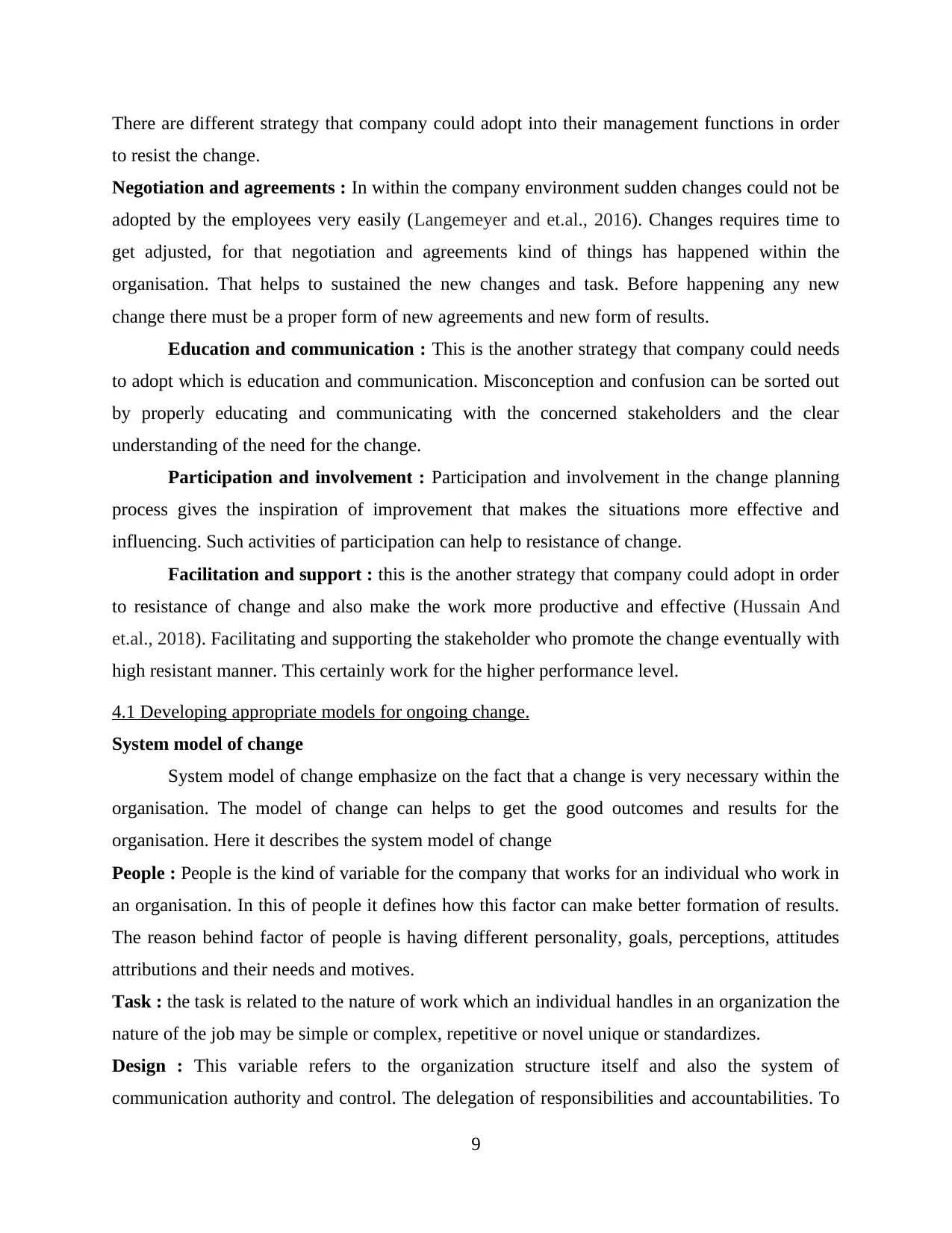
There are different strategy that company could adopt into their management functions in order
to resist the change.
Negotiation and agreements : In within the company environment sudden changes could not be
adopted by the employees very easily (Langemeyer and et.al., 2016). Changes requires time to
get adjusted, for that negotiation and agreements kind of things has happened within the
organisation. That helps to sustained the new changes and task. Before happening any new
change there must be a proper form of new agreements and new form of results.
Education and communication : This is the another strategy that company could needs
to adopt which is education and communication. Misconception and confusion can be sorted out
by properly educating and communicating with the concerned stakeholders and the clear
understanding of the need for the change.
Participation and involvement : Participation and involvement in the change planning
process gives the inspiration of improvement that makes the situations more effective and
influencing. Such activities of participation can help to resistance of change.
Facilitation and support : this is the another strategy that company could adopt in order
to resistance of change and also make the work more productive and effective (Hussain And
et.al., 2018). Facilitating and supporting the stakeholder who promote the change eventually with
high resistant manner. This certainly work for the higher performance level.
4.1 Developing appropriate models for ongoing change.
System model of change
System model of change emphasize on the fact that a change is very necessary within the
organisation. The model of change can helps to get the good outcomes and results for the
organisation. Here it describes the system model of change
People : People is the kind of variable for the company that works for an individual who work in
an organisation. In this of people it defines how this factor can make better formation of results.
The reason behind factor of people is having different personality, goals, perceptions, attitudes
attributions and their needs and motives.
Task : the task is related to the nature of work which an individual handles in an organization the
nature of the job may be simple or complex, repetitive or novel unique or standardizes.
Design : This variable refers to the organization structure itself and also the system of
communication authority and control. The delegation of responsibilities and accountabilities. To
9
to resist the change.
Negotiation and agreements : In within the company environment sudden changes could not be
adopted by the employees very easily (Langemeyer and et.al., 2016). Changes requires time to
get adjusted, for that negotiation and agreements kind of things has happened within the
organisation. That helps to sustained the new changes and task. Before happening any new
change there must be a proper form of new agreements and new form of results.
Education and communication : This is the another strategy that company could needs
to adopt which is education and communication. Misconception and confusion can be sorted out
by properly educating and communicating with the concerned stakeholders and the clear
understanding of the need for the change.
Participation and involvement : Participation and involvement in the change planning
process gives the inspiration of improvement that makes the situations more effective and
influencing. Such activities of participation can help to resistance of change.
Facilitation and support : this is the another strategy that company could adopt in order
to resistance of change and also make the work more productive and effective (Hussain And
et.al., 2018). Facilitating and supporting the stakeholder who promote the change eventually with
high resistant manner. This certainly work for the higher performance level.
4.1 Developing appropriate models for ongoing change.
System model of change
System model of change emphasize on the fact that a change is very necessary within the
organisation. The model of change can helps to get the good outcomes and results for the
organisation. Here it describes the system model of change
People : People is the kind of variable for the company that works for an individual who work in
an organisation. In this of people it defines how this factor can make better formation of results.
The reason behind factor of people is having different personality, goals, perceptions, attitudes
attributions and their needs and motives.
Task : the task is related to the nature of work which an individual handles in an organization the
nature of the job may be simple or complex, repetitive or novel unique or standardizes.
Design : This variable refers to the organization structure itself and also the system of
communication authority and control. The delegation of responsibilities and accountabilities. To
9
⊘ This is a preview!⊘
Do you want full access?
Subscribe today to unlock all pages.

Trusted by 1+ million students worldwide
1 out of 16
Related Documents
Your All-in-One AI-Powered Toolkit for Academic Success.
+13062052269
info@desklib.com
Available 24*7 on WhatsApp / Email
![[object Object]](/_next/static/media/star-bottom.7253800d.svg)
Unlock your academic potential
Copyright © 2020–2025 A2Z Services. All Rights Reserved. Developed and managed by ZUCOL.





